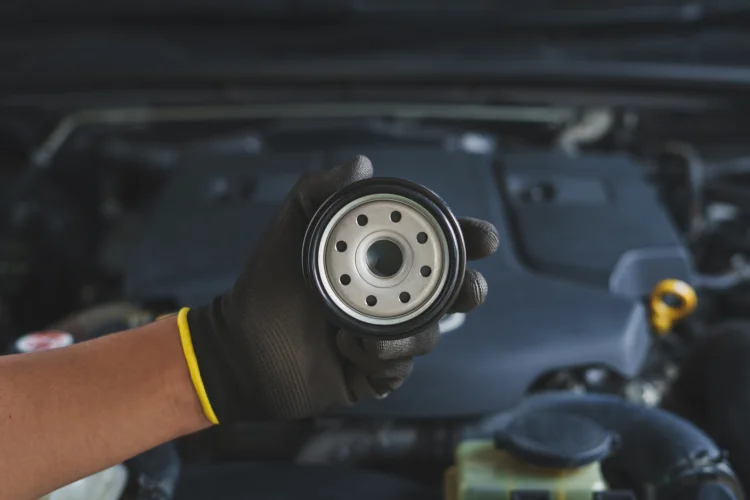How To Remove a Stuck Oil Filter (Without Damaging Anything)
stuck oil filter
1,104Changing your oil should be simple — until it’s not. If you’ve ever tried to remove an oil filter that just won’t budge, you know how frustrating it can be. A stuck oil filter can turn a quick oil change into a messy, knuckle-busting project.
Don’t worry — it happens to everyone. Whether it’s over-tightened, heat-seized, or just old, you can safely remove it with the right technique (and patience).
Here’s how to remove a stuck oil filter step-by-step — and how to avoid the problem next time.

Why Oil Filters Get Stuck
Oil filters are designed to seal tightly to prevent leaks, but sometimes they seal too well. Common reasons a filter gets stuck include:
-
🔩 Over-tightening during installation
-
🛢️ Old, hardened gaskets that have fused to the engine housing
-
🌡️ Heat expansion from engine operation
-
🧴 Oil residue buildup that causes suction between surfaces
If it feels welded in place — don’t force it just yet. A little technique goes a long way.
Tools You Might Need
Having the right tools makes all the difference. You may not need all of these, but having a few on hand can help:
-
🧰 Oil filter wrench (strap, cap, or band-style)
-
🪛 Screwdriver or punch tool (for extreme cases)
-
🔧 Socket wrench (for cap-type filters)
-
🧴 Penetrating oil (like WD-40)
-
🧤 Rag or rubber grip pad for extra traction
Step-by-Step: How To Remove a Stuck Oil Filter
1. Turn Off the Engine and Let It Cool
Make sure your car is off and the engine has cooled for at least 30 minutes. Hot oil and metal parts can cause burns.
2. Clean Around the Filter
Wipe away dirt and oil from the filter housing. This gives your wrench better grip and prevents debris from falling into the system.
3. Try Hand Pressure First
Wrap a rag or rubber jar opener around the filter and twist counterclockwise. A strong grip sometimes breaks it loose.
4. Use an Oil Filter Wrench
If hand pressure doesn’t work, try a strap or cap-style oil filter wrench.
-
Fit the wrench snugly around the filter.
-
Turn counterclockwise with steady pressure.
Avoid jerking or sudden force — that can crush the filter or damage threads.
5. Apply Penetrating Oil
If it’s still stuck, spray a small amount of penetrating oil around the base of the filter. Let it sit for 5–10 minutes. This helps loosen any dried oil or corrosion.
6. Use the Screwdriver Trick (as a Last Resort)
If the filter is damaged and all else fails:
-
Drive a long screwdriver through the side of the filter.
-
Use it as leverage to twist counterclockwise.
This should be your last option — it’s messy, but effective.
7. Check the Old Gasket
Once the filter is off, make sure the rubber gasket came off with it. If it’s stuck to the engine, carefully remove it. Leaving it behind can cause leaks when you install the new filter.
Can You Change Your Own Oil Under Warranty?
Yes — you can absolutely change your own oil while keeping your warranty intact.
Federal law protects your right to perform your own vehicle maintenance, including oil changes, as long as you use the correct parts and fluids recommended by your manufacturer.
Here’s what to keep in mind:
-
🧾 Keep your receipts for oil, filters, and parts.
-
📸 Record your mileage and date each time you perform an oil change.
-
🔧 Use manufacturer-approved oil and filters that meet the required specs.
-
🗂️ Keep a log or folder with all documentation in case of a warranty claim.
As long as you document your maintenance properly, your factory or extended warranty remains valid.
👉 Bonus tip: install an oil drain valve to make DIY oil changes a snap.
How To Avoid a Stuck Filter Next Time
When installing your new filter, follow these simple tips to prevent future headaches:
-
🧴 Lightly oil the rubber gasket before installation.
-
🤏 Tighten by hand only — about ¾ turn after the gasket contacts the base.
-
📅 Replace your filter regularly (every 3,000–5,000 miles, or as recommended).
Never use a wrench to tighten an oil filter — that’s the #1 cause of stuck filters.
When a Stuck Filter Signals a Bigger Problem
If your oil filter keeps getting stuck or shows signs of damage, it might be a sign of:
-
Cross-threaded installation
-
Wrong filter size
-
Excessive heat or oil pressure
Persistent oil filter issues can indicate deeper engine or lubrication problems. If you’re seeing oil leaks, burning smells, or performance issues, it’s worth having your vehicle inspected.
And if your factory warranty has expired, an extended warranty or vehicle service contract through Cuvrd can help cover repair costs for oil leaks, engine seals, and other related components — giving you peace of mind every time you change your oil.
Bottom Line
A stuck oil filter can test your patience, but it’s usually easy to fix with the right tools and a little know-how. Take your time, work safely, and remember — the goal is to remove the filter, not destroy it.
And if your car’s warranty is expired, you can protect yourself from bigger engine repairs with a Cuvrd vehicle service contract. It’s affordable, transparent, and covers you when DIY fixes turn into bigger problems.
Drive smart. Maintain smarter. Stay Cuvrd.
TL;DR: Got a stuck oil filter during your oil change? You’re not alone — it’s one of the most common DIY car maintenance frustrations. Whether it’s over-tightened, heat-seized, or just old, there are safe ways to remove it without damaging your engine. You can even change your own oil under warranty as long as you document it properly. Learn how to remove a stuck oil filter, avoid damage, and keep your car — and your warranty — in great shape with this simple guide from Cuvrd.
— Demetrius McGee
